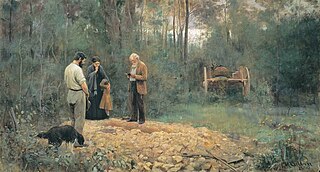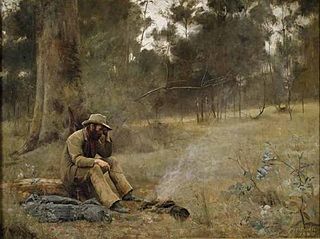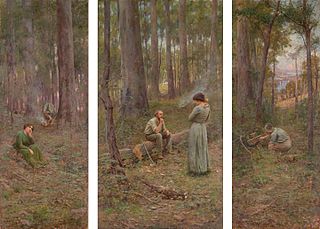 W
WA bush burial is an 1890 painting by the Australian artist Frederick McCubbin. The painting depicts a burial attended by a small group - an older man reading from a book, a younger man with a dog, and a woman and child. The relationships between the figures is unclear and its ambiguity and sentimental nature has seen the work described as a frontier example of the Victorian-era problem pictures. From the time the painting was shown at the Victorian Artists Society Winter Exhibition in 1890, there has been differing opinions on the story told by the work with "the critic for Table Talk magazine writ[ing] that the woman is newly widowed. In The Argus, she is the grief-stricken mother of a dead child." The Age referred to the "deceased, doubtless the wife of the grey-haired old man reading the service." The burial itself also refers to the memento mori tradition.Like Dutch vanitas pictures of the 17th century – with their skulls and snuffed candles, and fruit and flowers past their use-by date – McCubbin is reminding the viewer of the inevitability of death. You can almost hear the words being read over the grave: “Earth to earth, ashes to ashes, dust to dust.
 W
WBush Idyll is a 1893 painting by Australian artist Frederick McCubbin, and widely regarded as one of the finest masterpieces in Australian art history. The painting depicts a girl and boy - who is playing a tin whistle - lying on the ground near a lake.
 W
WDown on His Luck is an 1889 painting by the Australian artist Frederick McCubbin. It depicts a disheartened swagman, sitting by a campfire in the bush and sadly brooding over his misfortune. According to an 1889 review, "The face tells of hardships, keen and blighting in their influence, but there is a nonchalant and slightly cynical expression, which proclaims the absence of all self-pity ... McCubbin's picture is thoroughly Australian in spirit." The surrounding bush is painted in subdued tones, reflecting his somber and contemplative mood.
 W
WThe letter is an 1884 painting by the Australian artist Frederick McCubbin. The painting depicts a young woman reading a letter walking in the bush alongside a stream.
 W
WThe North Wind is a painting by Australian painter Frederick McCubbin, thought to have been painted in around 1888. The painting depicts a young family—the woman and child in a dray, the man and a dog on foot—making "its way down a bush track, buffeted by the treacherous ‘north wind’".
 W
WOn the wallaby track is a 1896 painting by the Australian artist Frederick McCubbin. The painting depicts an itinerant family; a woman with her child on her lap and a man boiling a billy for tea. The painting's name comes from the colloquial Australian term "On the wallaby track" used to describe itinerant rural workers or "swagmen" moving from place to place for work. The work has been described as "among the best known and most popularly admired of Australian paintings".
 W
WThe Pioneer is a 1904 painting by Australian artist Frederick McCubbin. The painting is a triptych; the three panels tell a story of a free selector and his family making a life in the Australian bush. It is widely considered one of the masterpieces of Australian art.